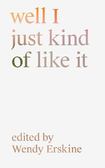
In a slim new anthology of visual art and prose, entitled well I just kind of like it, writer-turned-editor Wendy Erskine attempts to subvert the pomposity that surrounds much art and art writing and consider instead the art that permeates daily domestic life, and the daily domestic life – “that fruit bowl ... those rumpled white sheets” – that is art.
It’s an interesting project, held up by some strong, but (crucially) never self-important, works. In The Lady in My Living Room, writer Joseph Scott learns the significance of the “naked lady” in his mother’s livingroom – a painting which caused controversy when it appeared in the background of his A-level film project. In Tim Mara, author Nicole Flattery remembers “what it was like to feel something for art again” when she discovers the art of her father’s late cousin, Tim Mara, having become disillusioned with pop art while researching for a novel.
There’s a sense, throughout, of things that had been peripheral coming into focus. “The rug has been a feature of my life for as long as I can remember,” says Latifa Akay in The Rug on the Wall, yet considering this rug for the purpose of writing brings new understanding of her family history.
In keeping with the spirit of the book’s title, the range of work here is wide and idiosyncratic. Some of these works interact with one another, others stand alone. Some have appeared in shows or elsewhere, others are anointed by no one; art because they say they are.
READ MORE
Emily Dickinson’s poetry, Jo Broughton’s photography of empty porn sets, a conversation about psychedelic flowers between musician Heather Leigh and writer David Keenan – the approach is unpredictable. For the reader, it’s hard to sink in; we must constantly ask: what am I looking at?
But there is power in looking. Rumpled bedsheets gain pieta-like grandeur when Gareth McConnell photographs them in Meditation IV. A slice of ham gains inordinate significance when captured on a blank surface in Mauricio Alejo’s Ham.
Frances Stark’s The Architect and the Housewife, which first appeared in a catalogue for the 1998 exhibition Complementary by Michael Lin, feels like a central fulcrum. It analyses the domestic and the artistic deftly yet playfully, and, in expressing the role of an art catalogue, also gestures towards this book’s possible raison d’ểtre – “[It] ensures that a work – no matter how problematic or ephemeral, no matter how casual or whimsical – remains a work of art, and a portable one at that.”













